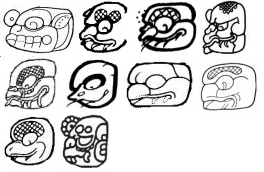




![]()
K&H.p80.#10 TOK.p28.r2.c1 TOK.p28.r2.c2 BMM9.p17.r4.c3 JM.p57.#2 = 25EMC.pdfp31.#5.3 JM.p57.#3
CHAN CHAN / KAN CHAN / KAN CHAN CHAN CHAN


K&L.p18.#4.1-10 [25EMC.pdfp31.#5.1&3 = K&L.p18.#4.8&3] 25EMC.pdfp31.#5.4
CHAN CHAN/KAN



Miller-NoaSP.p7.c2.fig5B Miller-NoaSP.p7.c2.fig5C Miller-NoaSP.p7.c2.fig5A
CLK Cleveland Stela DPL Stela 13 TIK Lintel 3
<K’UH{ul}:ka>:<KAN:AJAW> <K’UH{ul}:ka>:<KAN:AJAW> <K’UH{ul}:ka>:<KAN:AJAW>

25EMC.pdfp31.#5.5&6&7
CHAN/KAN
· These can be used to write sky.
· Variants (2):
o A. (Closed-mouth) snake head – features:
§ Curvy m-mouth with fangs – typically 2 or 3.
§ Left-feeler eye (optionally bold) optionally with one or two roundish, cross-hatched regions over the top half. This is present in more than half of the examples.
§ Optional donut / washer / circle of tiny dots as forehead ornament. In the examples, this element is present in TOK.p28.r2.c1, TOK.p28.r2.c2, K&L.p18.#4.1&3&10, 25EMC.pdfp31.#5.4, JM.p49.#4(?), and on all three examples taken from Miller-NoaSP.p7.c2.fig5 – CLK Cleveland Stela, DPL Stela 13, TIK Lintel 3.
o B. (Open-mouth) snake head – features:
§ 25EMC gives three examples of the snake with wide-open mouth:
· Do not confuse these with CHAPAAT = centipede. Distinguishing features are perhaps that the mouth of the snake is even more open than in the case of CHAPAAT, with the top part of the head / mouth so narrow that the glyph forms almost an L-shape, and the absence of two very distinct fangs at the end of the mouth (almost always present in CHAPAAT).
· Do not confuse these with the open-mouth variant of AHIIN (if that is indeed a valid variant). The open-mouth CHAN has a scroll in the eye, whereas the open-mouth AHIIN has crossed banks in the lower half of the eye. Also, the open-mouth CHAN never has the “bony” property marker whereas the open-mouth AHIIN can have.
· Houston-IU.p72.pdfp19.fig3.12 has an example of the open-mouthed snake, with clear indications that it refers to the Snake polity.
· When used as the EG of the “Snake Kingdom”, the initial phonetic complement of ka is always written, to show the reading of Kan rather than Chan. The example of CLK Cleveland Stela is particularly interesting as the ka is written with the full form of a fish, rather than the usual reduced form of a fish fin.
· While many epigraphers and reference works give the reading CHAN (with short-a), there are indications that it might have been a long-a (though probably already short in the Late Classic period). This is explained in Zender-TMMD.p7-8, in particular Zender-TMMD.p8.col1.para2.l+20.